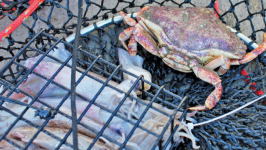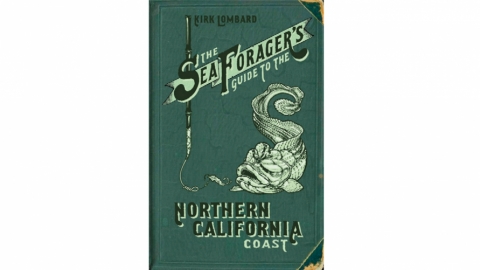The Sea Forager’s Tale
The sea forager lives in harmony with the rise and fall of the ocean tides. Kirk and Camilla Lombard are the founders of Sea Forager Seafood and Sea Forager Tours based out of their backyard—the Pacific Ocean. Kirk lovingly refers to Camilla as “the fishwife.” The moniker is fitting after hearing her seagull-like warning calls used to alert Kirk of the rising tidewaters. It is Camilla who answers my call to inquire about joining their family on a Mega Low Tide Expedition Tour of Half Moon Bay.
Kirk Lombard is the author of The Sea Forager’s Guide to the Northern California Coast. Pacific Ocean water courses through his veins, yet he has fond memories of fly fishing for trout in his youth with his grandfather in upstate New York. His many years spent as a fisheries observer for the Pacific States Marine Fisheries Commission trained Kirk in the way that only firsthand experience can. As if Kirk’s sea savvy wasn’t enough to impress the most knowledgeable angler, his deep respect and passion for ethical and sustainable fishing is still more inspiring. Sea Forager Seafood is a community-supported fishery (CSF) program with delivery locations around the Bay Area and South Bay that also offers coastal fishing and foraging classes. The following disclaimer on their website says it all: “Sustainability demands that we collaborate with local fishermen and appreciate the capricious whims of the ocean.”
Although Sea Forager Seafood hasn’t found it necessary to cancel a single delivery since opening almost four years ago, this disclaimer speaks to their commitment: It’s sustainably caught fish or bust for the Lombards. Kirk fills all his freshly dug clam holes and releases tasty catches smaller than the legal size. Others might not care, but Kirk does.
Minus Tide Time: Clam Diggers Delight
After scooping up a fat-tire stroller, Kirk, Camilla and their two young children, Django and Penelope, step into the early morning sludge of the minus tide at Half Moon Bay. Rubber boots are mandatory, as is a big dose of childlike wonderment. Kirk and Django begin squishing their fingertips on sand holes to release the squirt of the clam living deep underneath. Camilla and Penelope jump, jive and dance to create the necessary vibrations that cause the clam to withdraw its siphon deeper into its sandy depth, thereby unwittingly revealing its hiding spot with one quick water fountain. Time to start digging deep! A shovel does the trick at the outset before setting the clam tube in to dig by hand. At the key moment, Django readies himself to be lowered upside down into the tube to pull out Neptune’s buried treasure: a huge Horseneck clam. Kirk is elated. “It’s a big one. Let’s put it in the bucket.”
I marvel at the size and wonder how one cooks such a huge clam with its thick siphon. The siphon is that long tubelike tail sticking out of the clam, which it uses for breathing, locomotion and feeding. “You must pound it and chop it, of course, and then put it in the Crock- Pot!” The Fishwife’s Crock-Pot Manhattan Chowder is the perfect salve for any hungry Horseneck hunter (see recipe below.)
Ghost Shrimps, Moon Snails and Rockfish, Oh My!
California clam diggers are required by law to fill in their holes after clamming. Clams need tightly packed mud to travel and feed; loosely packed mudflats become clam-less ones. After Kirk fills in his holes, we walk farther out towards the rock jetty. Kirk stops to suck up a few ghost shrimps for bait, using a homemade PVC pipe pump. He suddenly drops to his knees and starts digging. Ever the teacher, Kirk employs Django’s assistance and together they uncover the magical moon snail. Years of trial and error in the kitchen have taught Kirk that this meat is not so tender or tasty, so he restores the moon snail back to its hiding spot.
Once we reach the jetty rocks, Django and Kirk pull out bamboo poke poles, which Kirk baits with a piece of squid while his son waits in anticipation of catching an eel or rockfish. Django’s first bite catches him by surprise. It’s a rock crab, which Kirk claims are more delicious than the famous Dungeness crab, but it’s not of legal size so he tosses it back. Suddenly, I hear the distant cry of a seagull’s caw. It’s the call of the fishwife; she’s warning us the tide has risen significantly. Kirk takes Django on his back to make their way to the flats, satisfied with the morning’s gifts. To observe a family foraging for sea treasures with such respect for the ocean and its creatures makes a lasting impression.





